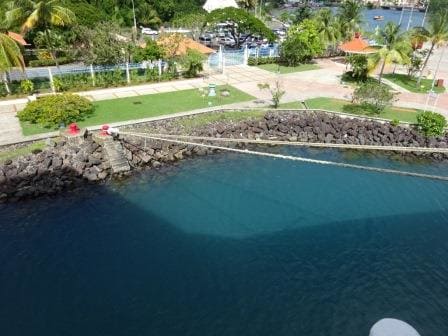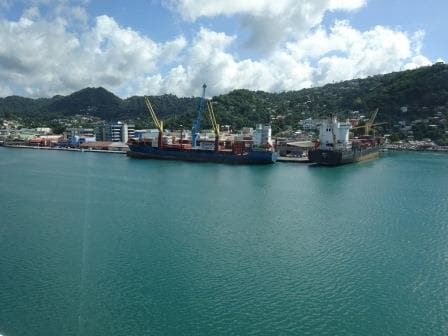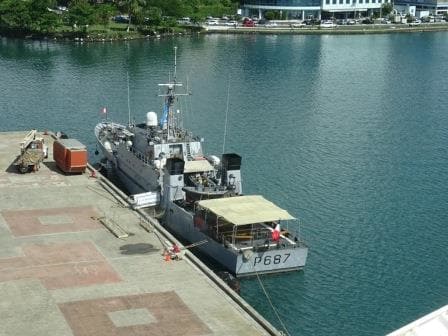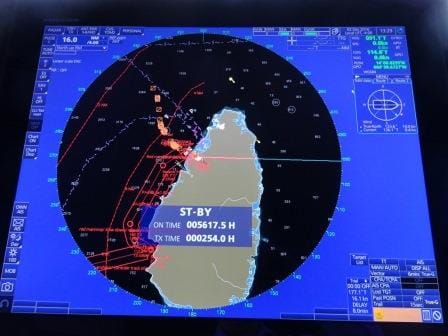Castries is most of the time a great port to be in. It is sheltered from most winds, it has fairly deep water and if you are not at the downtown dock, the larger cruise dock has a small shopping village which satisfies those who do not want to go very far. For the captains the most brilliant thing is the airport which is located right at the entrance. The airport – control – tower, which is manned by the time we arrive can give the exact wind strength in the port. On the off chance there is too much wind in the port the ship can then decide to stay out and does not have to abort at the very last minute. It seldom happens but we always prepare for the worst scenarios.
There are several docks in Castries but most cruise ships dock at the two cruise terminals which leaves the downtown pier open for the cargo ships. We were the only cruise ship in port today, the 2nd cruise Terminal was taken over by a French patrol boat and the Elizabeth dock at the down town side was indeed occupied by cargo ships coming and leaving. Most of them are involved in a feeder service to Panama, Aruba or to Miami; where the long distance containers are transferred to the very large containerships on the worldwide routes.
France has 21 of these patrol boats and this one listens to the beautiful name La Gracieuse. The French Patrol boat was not an un-expected appearance as this part of the Caribbean Sea is looked after by the French because their islands are just around the corner. Most islands in the Caribbean Sea are independent or only loosely attached to an old home country but Martinique and Guadeloupe is fully part of France. One of the reasons these islands are so much more expensive to visit as the prices are the same as in France itself. St. Lucia is part of the British Commonwealth which means it runs itself but the British Queen is still the official Head of State. When we come to Curacao and Aruba we will see Dutch patrol boats and helicopters as they guard that part of the Caribbean. Main job for all these patrol boats is to try to keep Drug runners from coming out of South America and making it to Puerto Rico or even the USA.

These are the forward breast lines which run over water to the shore. Note the silver circular shields on each rope.
As you can see from the photo the dock is very small and so is the berth where the Oosterdam is docked. As a result we run long lines to bollards and mooring buoys far away. This makes the docking process on arrival quite a time consuming affair. Each line has to be brought ashore by boat and then pulled over the bollard. Because these bollards are almost inland and the vegetation close by, we take extra care here to have Rat-Shields or Rat-Guards in place on the mooring ropes. These things come in a variety of designs and then they are normally painted by the sailors – just for the fun of it —- Hence there is no rhyme nor reason what is used by a ship but some ships just keep them as is with the Galvanized silver color. So as soon as the ship is docked a sailor with a trolley comes out of the ship and puts on each rope a shield. We prefer to do it from the shore where we can tie them up better than shipside as otherwise they might be blow off by the wind. If we cannot get at them because the ropes are on a dolphin or mooring buoy then we hang them from the ship.
There were times when they were compulsory in any port in the world, and there would be heavy fines if they were not in place. For the W.H.O organization they are not compulsory anymore as the ships do not really carry rats anymore. The poor rat that climbs onboard dies a certain death due to lack of food. Still most countries recommend it and also the American Navy health regulations still demand them. So we put them on as in that way, we will always be in compliance.
As long as I have been sailing here, St. Lucia always was a shorter stay. Invariably the ships sailed before 15.00 hrs. as they then went to Soufriere to pick up the Overland Tour and do a scenic sail bay of the Pitons, two Volcano cones which rise straight up out of the Jungle. We will also do the sightseeing again and afterwards sail westwards towards Willemstad on Curacao. So tomorrow will be a restful sea day.




December 2, 2016 at 3:57 pm
Captain,
Thank you for responding to my comment regarding rat guards. Very interesting.
Thank you for your blog, I’ve been following it several years now.
Bob
December 3, 2016 at 9:26 am
Can you tell me what day the Konningsdam arrives back in FL this weekend is it Sat Dec 03 or the 4th
Thank you
December 3, 2016 at 11:39 am
Thank you for reading my blog.
the Koningsdam will be back in Fort Lauderdale on Sunday 04 December from 0700 to 1600 hrs.
Best regards
Capt. Albert
December 6, 2016 at 9:30 pm
Thank you too for all the details regarding the rat shield/rat guards, Captain. I remember you covering an incident of a large four-footer climbing on board via the lines going to shore, photos included, and how the crew subdued the big animal.
Regarding our harbour in downtown …. I have encountered rats and plenty mice on the way to the cruise ship docks, whether hungry or not. You wouldn’t want to have them on board any way, would you?